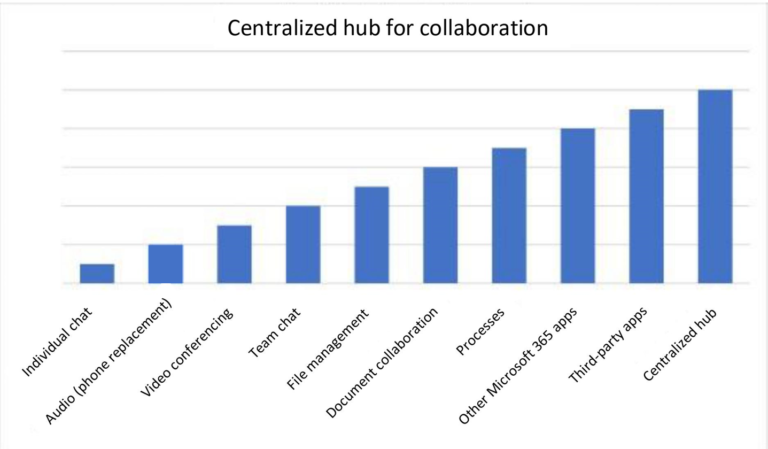Are companies being strategic about how they use Microsoft Teams?
To be strategic, one must have a vision and a plan. Microsoft Teams is a technology we use for audio and video conferencing. That could be a vision statement, and all a company needs to do is enable it for the organization and send out an email. So, the word “strategic” is dependent on who has the vision and what the vision is.
Companies that look beyond the features of online meetings and chat, and consider the employee experience can state a completely different vision. My sister owns Common Cider Company, and I took them into Office 365 early in their life as a company. She made this statement, “I want our sales team to be able to access all the sales data in Teams. It needs to be easy and they can do it from their phone.” That vision statement drove the first initiative for how they were being strategic with their sales data, Microsoft Teams, and the employee experience.
In the case of Common Cider Company, as a strategic move, they looked at how Microsoft Teams could help their sales team in the field. There are numerous business problems that could be addressed or alleviated by building a solution within Microsoft Teams. The first step towards being strategic is asking the question, “What problems do we have and can Microsoft Teams help us solve those problems?”
Is Microsoft Teams safe from data loss?
I think the better way to ask this question is, “Can a company experience data loss with Microsoft Teams?”
As an application that is part of a bigger platform, Microsoft doesn’t “own” the data, so any loss experienced would be that of the subscriber.
As a platform, it’s growing and will continue to grow, but like any applications that hold business data, it’s not perfect. In the early days of Microsoft 365, there were times I would go back to a SharePoint site and something I fixed the day before was back in place. It almost felt as if the SharePoint site had been restored from a backup. It’s been a couple of years since something like that has happened. The platform is more stable today than it was last year or five years ago.
As for the data, I think the loss of data would be more rooted in the admins, users with access, and yes, people with intent to do the company harm.
How can a company protect their information in Microsoft Teams?
As a solution architect, I’ve designed solutions within the Microsoft ecosystem that typically included multiple applications. Solutions weren’t always built using any one app. I believe the same applies to protection of information for Microsoft 365. The security and compliance of Microsoft 365 is unparalleled, but companies don’t always take advantage of what is available. Microsoft’s assumed breach methodology is in place to help their customers do everything possible to keep their information safe, but customers have the responsibility to build upon this foundation.
It was never a question that a company protect their investment, infrastructure, and content behind the firewall. They backed up their VMs, their SQL Servers, their file servers, etc. They did so because they needed to recover from situations they didn’t anticipate or consider.
The same should apply to the content within Microsoft 365. With the widespread adoption of Microsoft Teams over the last year, the importance of being able to recover information in Microsoft Teams can’t be overstated. Using a data protection platform such as those offered by Druva should be part of how an organization maintains control and supports security and compliance requirements. As an organization explores how Microsoft Teams can help in its business goals, it will need to take measures to ensure it can recover from harmful acts, whether intentional or unintentional, such as ransomware.
Do you have any parting thoughts you’d like to share about Microsoft Teams?
I have many, but I’ll keep it to one.  I’m not fond of private channels. I believe that every Microsoft Team created should have a purpose and the users with access to that team be able to see and interact with any information in the team. The purpose stated drives what is there and the model of security for that information. So, if the purpose changes and now there are several private channels with different purposes, each one of those private channels has lost the ability to take advantage of what an independent team could do. As an architect, I consider things like data classification, security models, and the end-user experience; so instead of having one Microsoft Team for marketing that has a private channel for managers, just create another team for marketing managers. I could go into more detail about this topic, but I’ll save it for a different session.
I’m not fond of private channels. I believe that every Microsoft Team created should have a purpose and the users with access to that team be able to see and interact with any information in the team. The purpose stated drives what is there and the model of security for that information. So, if the purpose changes and now there are several private channels with different purposes, each one of those private channels has lost the ability to take advantage of what an independent team could do. As an architect, I consider things like data classification, security models, and the end-user experience; so instead of having one Microsoft Team for marketing that has a private channel for managers, just create another team for marketing managers. I could go into more detail about this topic, but I’ll save it for a different session.
Looking to further explore how to enhance workplace productivity and address data protection gaps with Microsoft 365? Download our cloud architect’s guide for tips on transforming your Microsoft 365 strategy.




